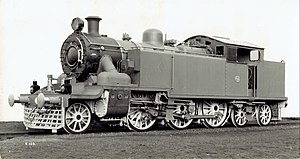Indian locomotive class PT
| Indian locomotive class PT | |||||||||||||||||||||||||||||||||||||||||||||||||||||||
|---|---|---|---|---|---|---|---|---|---|---|---|---|---|---|---|---|---|---|---|---|---|---|---|---|---|---|---|---|---|---|---|---|---|---|---|---|---|---|---|---|---|---|---|---|---|---|---|---|---|---|---|---|---|---|---|
 Robert Stephenson & Co. work's photo of SIR No.10 (RSC No.4117) | |||||||||||||||||||||||||||||||||||||||||||||||||||||||
| |||||||||||||||||||||||||||||||||||||||||||||||||||||||
| |||||||||||||||||||||||||||||||||||||||||||||||||||||||
| |||||||||||||||||||||||||||||||||||||||||||||||||||||||
| Reference: [3][4][5] except where noted. | |||||||||||||||||||||||||||||||||||||||||||||||||||||||
The PT class (Passenger Tank) was a broad gauge tank locomotive designed to haul passenger trains on the railways in British India. It was one of the BESA locomotives developed by the British Engineering Standards Committee, later called the British Engineering Standards Association (BESA).
History
[edit]The PT class was first catalogued in the second edition of the BESA report on standard locomotive classes for the railways of British India of 1907.[6] Robert Stephenson and Company built seven PT class locomotives for the South Indian Railway (SIR) in 1936, bearing works numbers 4114 to 4120.[2] This batch differed significantly from the earlier F and FS classes (which correlate to the original BESA design with internal valve gear) by being fitted with outside cylinders.[1] In service, the locomotives were used in heavy suburban traffic, and were numbered 7 to 13.[2] Number 11 has been preserved and is on display in the National Rail Museum of India in New Delhi.[7][8]
Design
[edit]
Three design variants of the PT class, each with different boilers, were listed in the BESA report. A larger standard boiler with a diameter of 5 ft 1 1⁄4 in (1556 mm) was developed for the PT, which was also listed as a variant in the third BESA report for the SP and SG class locomotives.[9] Alternatively, the existing boilers from the SP and SG classes could also be used, provided that the weight of the locomotive was altered in accordance with the requirements of the report.[6] The PTS variant was fitted with a Schmidt superheater - the S stands for superheated.[5] In contrast to the design recommendations of the BESA report, the SIR locomotives were fitted with external Lentz rotary valve gear.[1]
References
[edit]- ^ a b c d Hughes 1979, p. 70.
- ^ a b c d e Historical Railway Images (2018-01-08). "India Railways - South Indian Railways 2-6-4T steam locomotive Nr. PT10 (Robert Stephenson Locomotive Works 4117 / 1936)". Retrieved 2020-08-30.
- ^ "History of Steam: Broad Gauge". www.indiansteamrailwaysociety.in. Archived from the original on 2016-06-29. Retrieved 18 July 2024.
- ^ Second report of the Locomotive committee on standard locomotives for Indian railways. February 1907. p. 13. Retrieved 22 September 2024.
- ^ a b Hughes 1979, p. 18.
- ^ a b Second report of the Locomotive committee on standard locomotives for Indian railways. February 1907. p. 6. Retrieved 17 July 2024.
- ^ Wojtkowiak, Maciej. "Steam Locomotive PT 11 Constructed in Britain and used also in India".
- ^ Hughes 1979, p. 91.
- ^ Indian Industries and Power, Volume 7. 1909. p. 275. Retrieved 17 July 2024.
- Hughes, Hugh (1979). Steam locomotives in India, Part 3 – Broad Gauge. Harrow, Middlesex: The Continental Railway Circle. ISBN 978-0-9503469-4-6.
External links
[edit]- Maciej Wojtkowiak. "Steam Locomotive PT 11 Constructed in Britain and used also in India". Alamy. Retrieved 2020-08-30. Preserved PT class locomotive number 11 in the National Rail Museum of India, New Delhi




